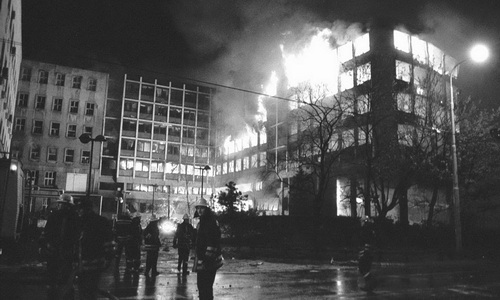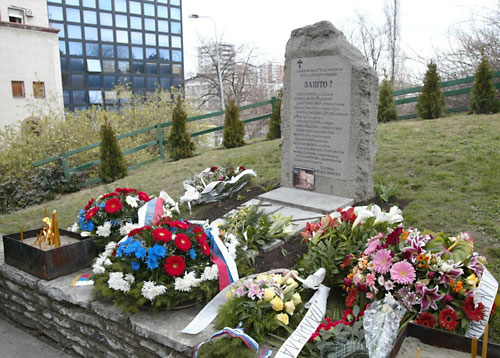Author’s note: I am a journalism student, so I wrote this in partial fulfillment of an assignment for my study abroad program on April 23rd, the anniversary of a bombing that killed 16. The NATO bombings are a sensitive topic in Serbia, but as an American I didn’t hear about them until I met some Serbian students in college. It was really revealing to speak with the people in this article, and challenging to reconcile my own “outsider'” perceptions to the tension between everything around me-physically and ideologically! But that’s what study abroad is all about, isn’t it?
BELGRADE – It is very quiet in this part of Tašmajdan Park, a stark contrast to what would have been a deafening sound 16 years ago when the building across the parking lot — Belgrade’s RTS (Radio Television Serbia) — was hit with a NATO missile, killing 16. But now the building stands half-obliterated, silent and exposed. Such a poignant reminder that, even when tucked behind St. Mark’s Church on one of Belgrade’s busiest boulevards, is still a raw and emotional sight.
On April 23, 1999, six hours before the strike, journalist Sanja Radan, who worked for RTS at the time, left work to stay in her friend’s home, concerned her apartment was too close to potential bombing targets in the city center. “Suddenly my friend and I heard specific sound of projectile flying over the building,” said Radan.
“The first pictures of that ruined building of RTS were played on city television Studio B…Pictures of people stuck in the rubble, without arms and legs, wounded and killed,” she said. “I started screaming, it was my first reaction that was stronger than me.”

The RTS building in Belgrade, Serbia, burns after it was hit with a NATO missile on April 23, 1999, killing 16 inside. Photo via SerbiaSos.
The bombing was part of the NATO mission to force withdrawal of Serbian forces from Kosovo, it’s southern autonomous province at the time. During the split of Yugoslavia in the early 1990s, ethnic Albanian Kosovars began pushing for independence from Serbia. NATO, who intervened to end human rights violations against the Kosovars and later supported the Kosovo declaration of independence in 2008, justified bombing RTS due to its role as the Milosevic (Serbian president) administration’s main propaganda arm.
Unlike previous targets, the RTS was not completely evacuated before the strike. Some, like journalist Tamara Skrozzo, believe that the government used the 16 deaths—all technicians, not journalists—for their own purposes: “There is a theory that those people were put there as targets; that the government was informed but refused to evacuate in order to use the victims for their propaganda…I believe it 99.9 percent,” she said.
Others maintain that NATO should never have bombed a civilian building. Even Skrozzo, who was a young “opposition” journalist for an independent anti-Milosevic radio station in 1999, agrees.
“Those people who were killed weren’t the editors or journalists supporting Milosevic, but technicians who just wanted to feed their families and live their ‘ordinary’ lives,” she said. “Being angry [about it] doesn’t describe the feeling.”
While RTS manager Dragan Milanovic was sentenced in 2002 to ten years in Serbian prison for failing to protect his employees—the only conviction in relation to the bombing so far, Serbian, NATO or otherwise—many questions remain unanswered.
But no answers, no reason and no blame will bring the 16 employees that perished in RTS’ rubble back to their families. These are the sixteen families that erected a small monument in this sleepy corner of Tašmajdan. An upright stone sits opposite the bombed remains of RTS heralding “Zašto?” —which means “why?”—in Serbian Cyrillic to passersby.
It seems that all of Serbia, like Radan, identifies with these families’ pain. “I can’t sleep at night like so many Serbian people…[The families] are still asking themselves “why” just like me,” she said.

Flowers for the bombing’s 16 victims are laid in front of a monument the 16 mourning families erected in Tasmajdan Park. The current RTS building can be seen in the background. Photo via B92.
“It’s really a tragedy, but you know in wars and situations like that, it happens. Always innocent people,” said 21 year old student Nevena Nikolić. Only six years old during the campaign, Nikolić’s three year old friend was killed in her home by wayward shrapnel from a different hit in Belgrade.
Between them—Radan, Skrozzo, and Nikolić—none denies the questions and pain still present in Serbian society. Some remains, like half-destroyed buildings, serve as everyday reminders. Nikolić said, “We have these scars, like destroyed buildings and such. But you know it’s more than 15 years from that moment…Now you just live with it.”
“[The buildings] are a small punch in the chest whenever I go by them, a reminder that is neither constructive, nor painful—just emotional,” said Skrozzo. “However, I wouldn’t change those remains, wouldn’t reconstruct the buildings, just like I wouldn’t change my memories of the bombing. Those were very hard times…but also times of getting to know yourself, rearranging your priorities and times of growing up.”



